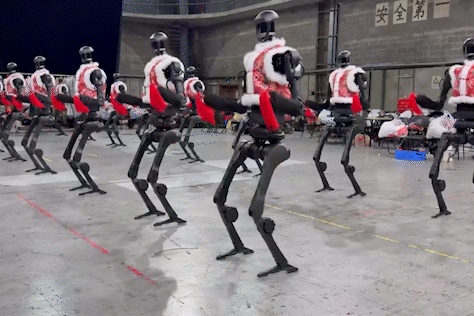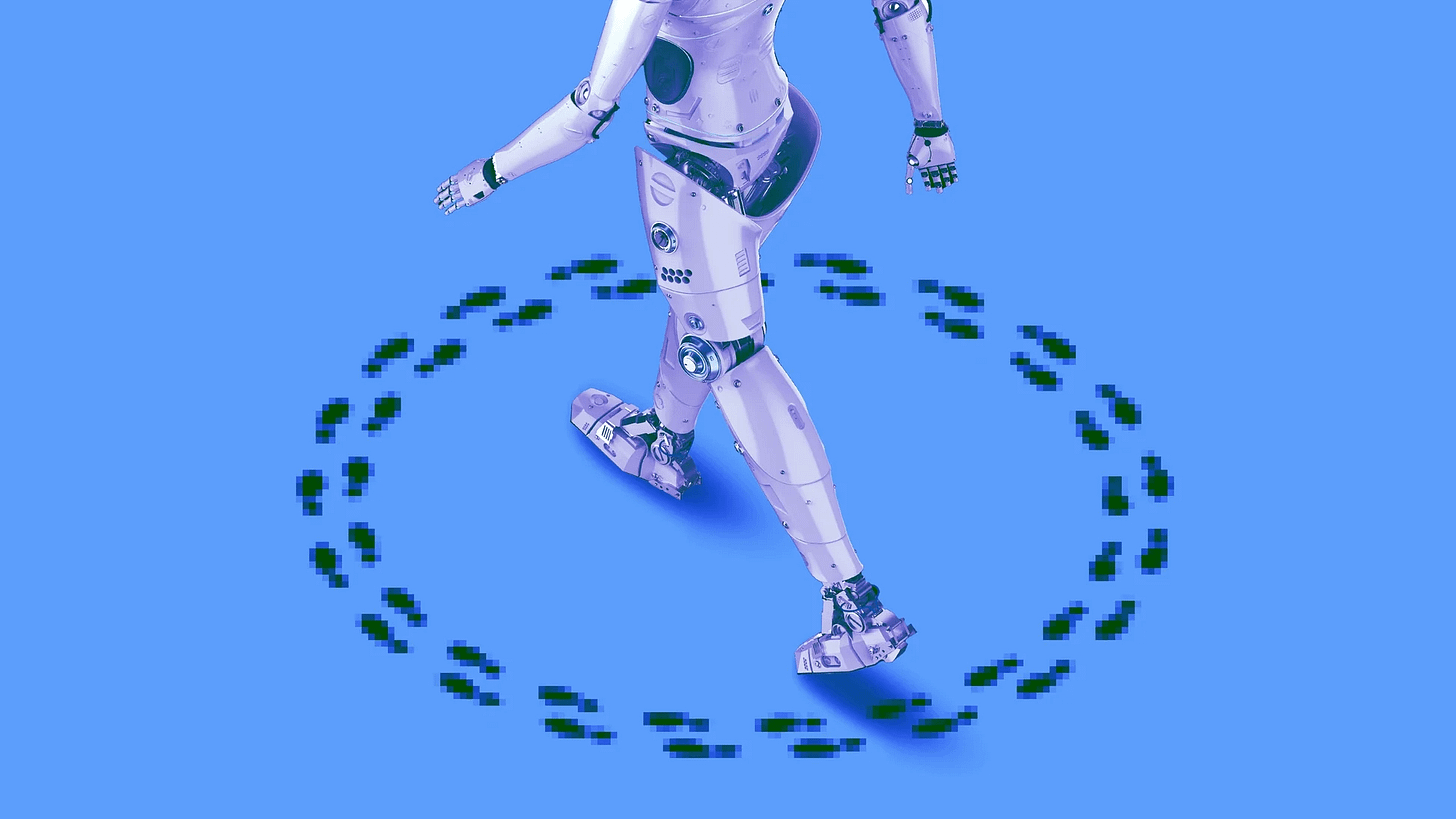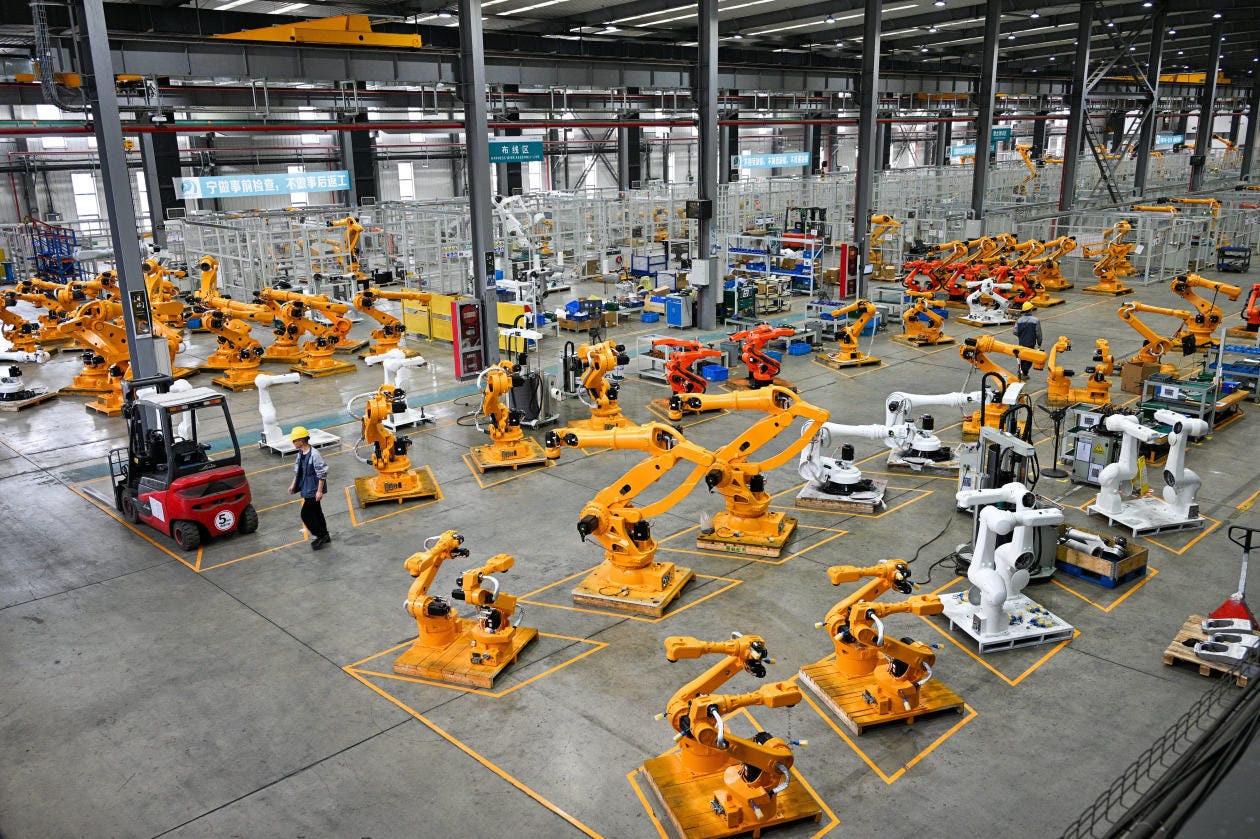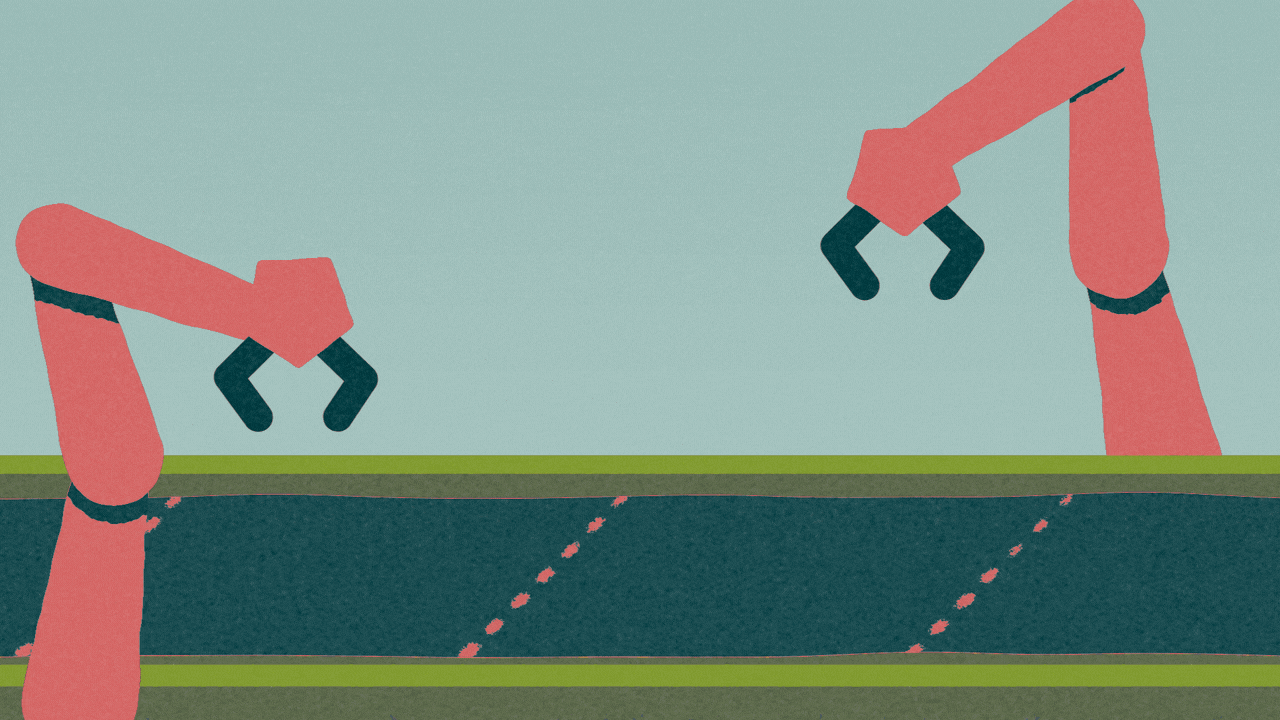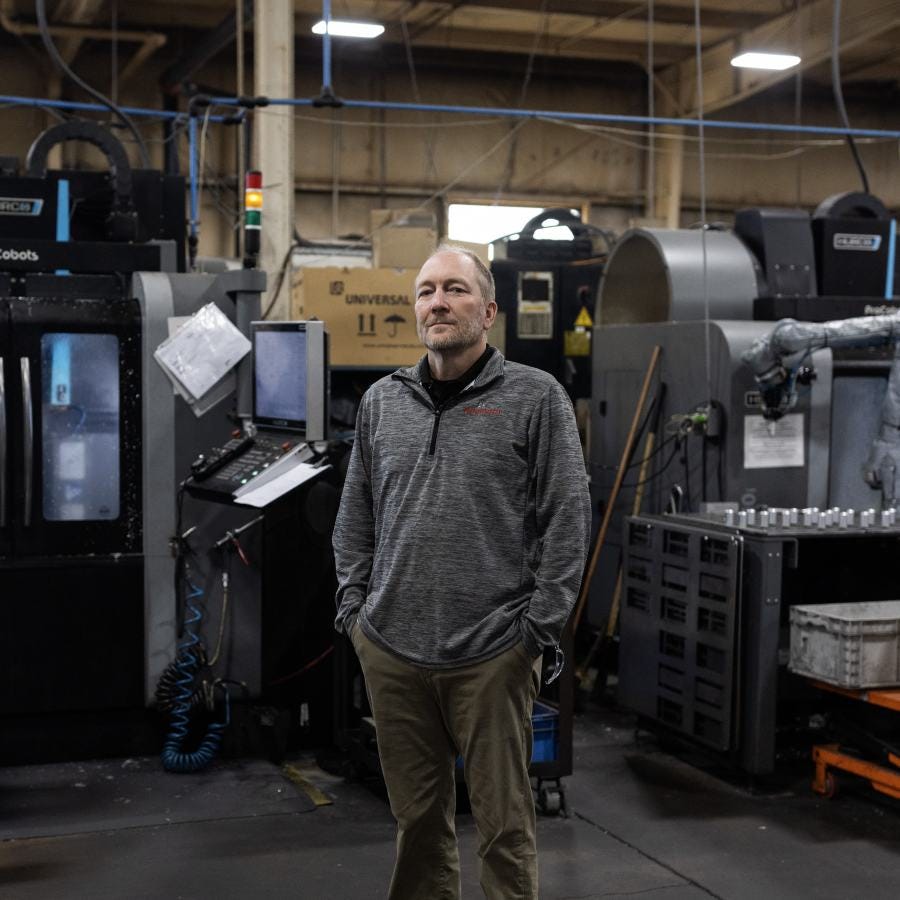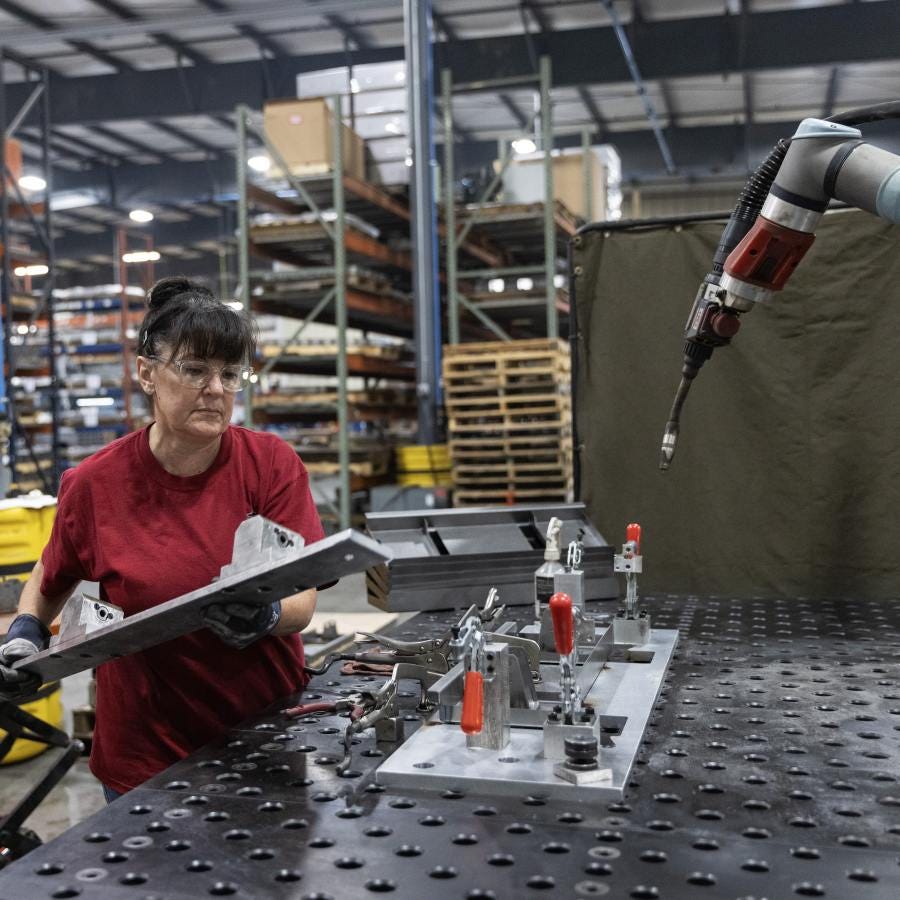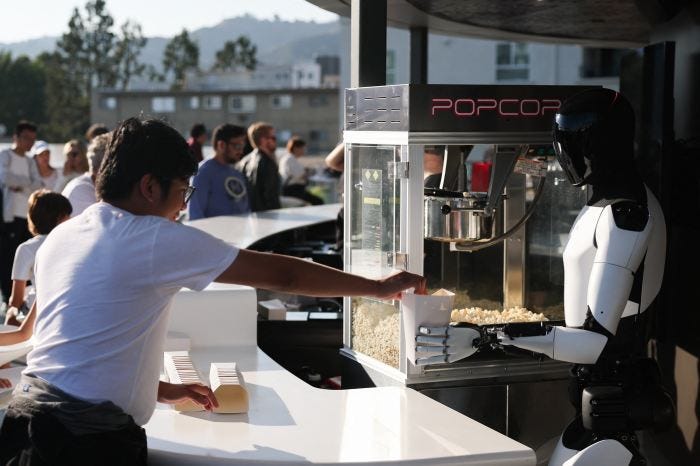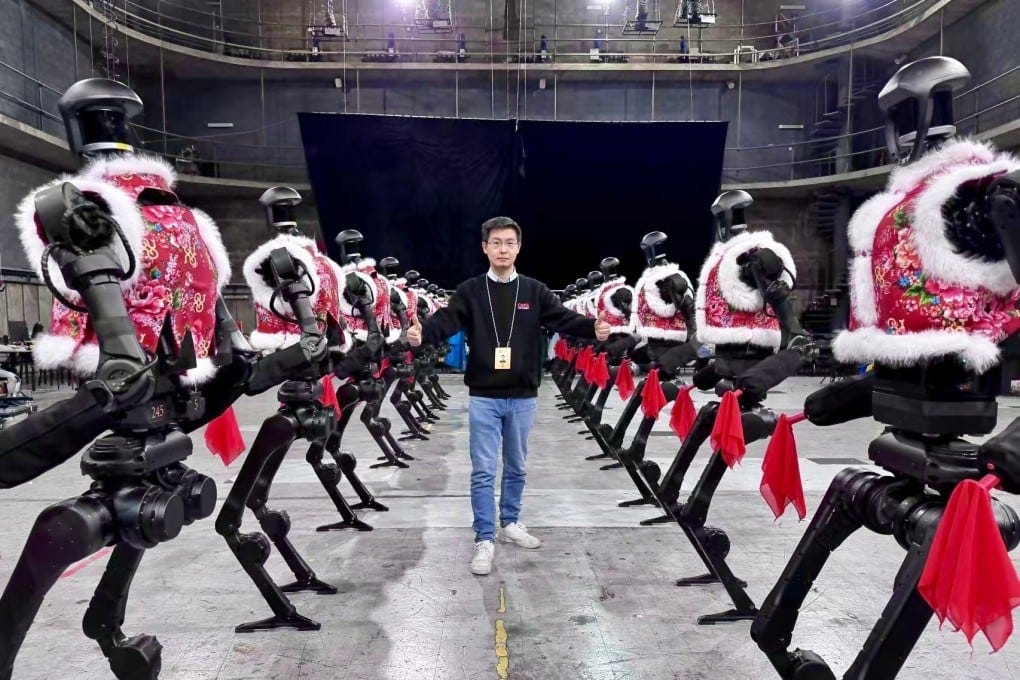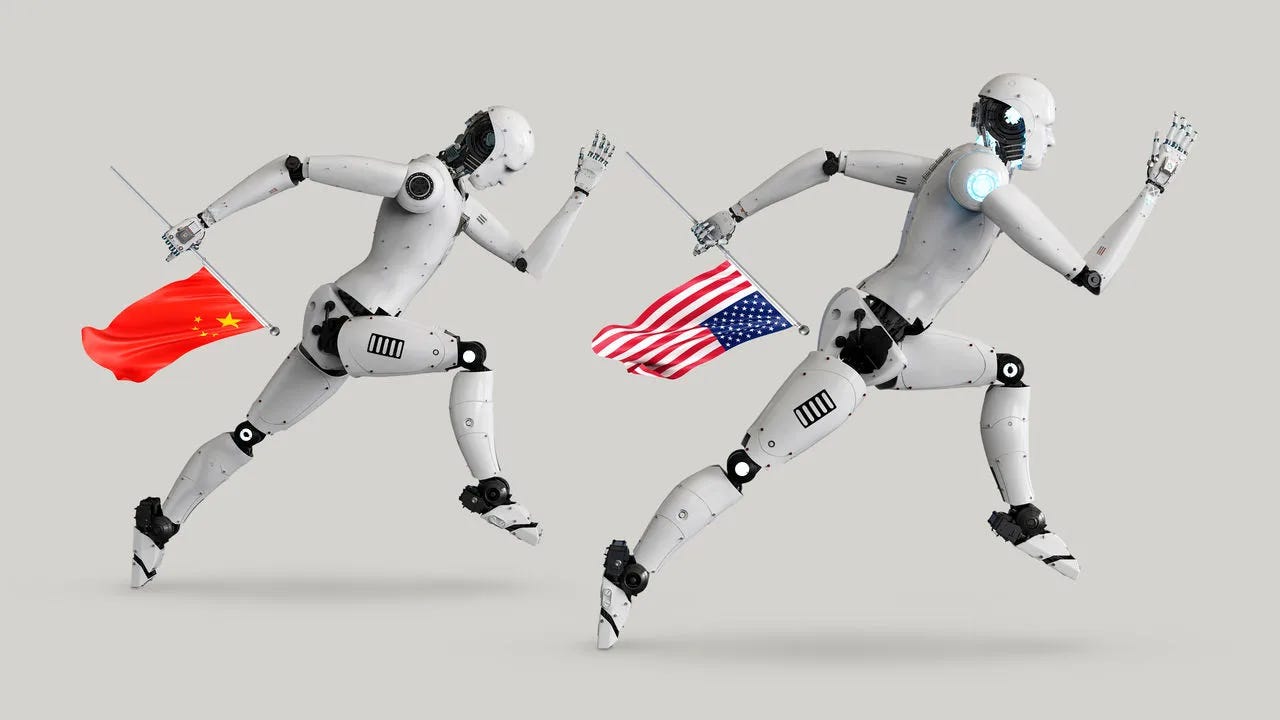AI: US vs China update on AI Robotics. RTZ #873
...ramping efforts here vs China's strong ecosystem advantages
I’ve long discussed the US vs China AI Robots race in these earliest of days of the AI Tech Wave.
The general gist is that China is ahead on a range of dimensions, especially in their manufacturing ecosystems for everything from Robots to self driving AI cars and EVs. But the US is making headway here from a slow start, and it’s worth discussing.
The WSJ discusses the latest landscape in “America’s Manufacturing Resurgence Will Be Powered by These Robots”:
“China has more industrial robots than the rest of the world combined, but newer, more flexible robots are keeping smaller U.S. manufacturers in the fight.”
“In small factories across America, agile automatons are making everything from parts for AI supercomputers to the hulls of America’s future autonomous naval weapons.”
“Once a luxury reserved for big manufacturers, smaller, smarter, more flexible and less expensive “cobots”—collaborative robots—are bringing automation to every fabricator, no matter the size. These robots aren’t just nice to have. The slow, fragile recovery of American goods production wouldn’t be possible without them.”
‘Cobots’ are the new buzzword. And the US deploying them in a range of industries:
“The number of U.S. companies that make physical things reached a low point in 2014 and has grown since then. Yet they are trapped in a never-ending labor shortage as skilled workers age out, and young people fail to take their place.”
The base case of China’s dominance is straightward to lay out:
“China has become the de facto manufacturer of the world’s goods, owing not only to its enormous population of engineers, technicians and machinists but also its 2-million-plus army of industrial robots. Now the U.S. is attempting to claw back some of those contracts—a process called “reshoring”—and robots can in some cases quadruple worker output.”
The challenge is matching demand vs supply. Both in terms of bottoms up manufacturing, and financial cycles at times driven by headwinds of US/China tariff and trade wars.
“There’s always a danger that companies will over-automate, a trap that has sent many a firm into bankruptcy when recession kicked in, demand dried up and equipment weighed on balance sheets. There’s also a hazard in thinking robots can do everything—adding them generally requires finding humans to work alongside them.”
“But for now at least, the push to bring manufacturing back to the U.S., and the demand for industrial goods to power America’s AI-fueled economy, are driving automation adoption and innovation.”
““Automation is key to reshoring, plain and simple,” says Greg LeFevre, CEO and president of Raymath, a metal fabrication company based in Troy, Ohio.”
“When he bought Raymath in 2019, this maker of food-grade machines, earthmover parts, data-center server cabinets and more was nearly four decades old and had almost no automation. Two years later, LeFevre began adding cobots, a kind of lighter, less expensive, easier-to-program industrial robot that’s safe to use around humans. Now he has 13.”
“Per-worker productivity at his facility has soared, with individual workers producing as much as four times as many pieces per day as they could before. This makes Raymath more competitive, and has helped the company triple its revenue. LeFevre has also been able to slightly expand the company’s workforce, from about 130 to 145 workers. Humans have gone from doing all the grinding, welding, machine-operating and parts-moving to overseeing and collaborating with robots who take on the bulk of the tasks.”
“These robots have become radically easier to program over the past decade, and now people can use a simple tablet interface to instruct them to perform specific sequences of actions. Programming the older robots common in automotive factories since the 1960s took years of training.”
“Dozens of companies in the U.S. now offer manufacturers the kinds of specialized welding cobots that LeFevre uses, says Josh Pawley, co-founder of Loveland, Colo.-based Vectis Automation. Founded in 2019, Vectis was one of the earliest U.S. companies to assemble welding cobots. (LeFevre’s shop uses robotic welders from a competitor, THG Automation, based in Indianapolis.)”
“These metalworking cobots are part of a broader trend in robotics: Specialized robots that use sensors to safely navigate human environments. They can cope with more variability than previous industrial robots, which had no sensing abilities. This has been essential to the rise of Amazon and its superfast fulfillment, and now it’s coming to manufacturing.”
It’s important to note that the robots discussed above are different from the headline grabbing, popcorn serving robots by Elon Musk’s xAI and other humanoid Optimus robot ventures.
A lot more basic ‘humanoid’ technologies have to be figured out. Some of the hardest technical issues are around AI robotic hands, and AI robot data, as I’ve discussed at length in fields ranging from food services to robots in the home.
“Manufacturing cobots are a far cry from the humanoid robots which have garnered so much attention of late. Elon Musk has staked a compensation package that could be worth a trillion dollars on his promise that Tesla will produce a million Optimus robots within a decade.”
“Humanoid robots lack strength, dexterity and specialized appendages—like welders or grinding wheels—but startups building them are betting they compensate through versatility. Perhaps they might unpack boxes in the morning, then pack other boxes in the afternoon. Someday they could, in theory, pick up a welder or a grinding tool, but making them dexterous enough is a huge challenge. Musk recently said that for Optimus, “the hands, inclusive of the forearm, are a majority of the engineering difficulty of the entire robot.”"
China is of course ahead in the scale of its manufacturing ecosystems, with its leading companies like Unitree in the race:
“China is indisputably the leader in high-volume manufacturing, and companies that want the biggest volumes of manufactured parts for the lowest possible price continue to send work there. And though many U.S. manufacturers can’t match their Chinese peers in volume, they are competing by using automation to tackle smaller batches of goods under tight deadlines.”
“Clients that wouldn’t have thought of manufacturing in the U.S. are now asking how to reshore the making of critical parts, says Jack Callender, president of Caltech Manufacturing in Bucks County, Pa.”
And the economic competition is tough.
“Each metal part his shop makes—for medical devices, vehicles, scientific and industrial systems and more—can cost more than the quoted price for a piece from China. But customers who contract with him are choosing to avoid some of the challenges of overseas manufacturing, he adds.”
And the efforts here are finding capital partners:
“U.S. investors are making bets on yet-to-be-proven technologies that could yield even more capable robotics.”
“Bay Area-based Dyna Robotics is making a “foundation model” for manufacturing robots. This means they learn to perform tasks, instead of being programmed to do them. Today, the startup’s robot can fold dinner towels, but soon, the firm will partner with real-world factories to expand that skill set, says Lindon Gao, the company’s CEO. His company announced last month it had raised $120 million from investors including Nvidia and Amazon.”
US big tech companies from Nvidia to Google to Meta to OpenAI to Amazon to many others are in the race.
“It’s a long-term play. Making these learning robots reliable enough for an industrial environment is next to impossible at present, says Christopher Müller, director of the statistical department at the International Federation of Robotics.”
“That’s not stopping Gao, who hopes to deploy them within a few years. Once robots can be set to work with a quick demo and some verbal commands, the country that can muster the most robots—rather than the most workers—wins.”
The whole piece is worth a read for additional details, but for now its clear that a lot is stirring in the US on the AI Robots front. A
nd there’s a long way to go in this AI Tech Wave for all things robotic AIs. Stay tuned.
(NOTE: The discussions here are for information purposes only, and not meant as investment advice at any time. Thanks for joining us here)


